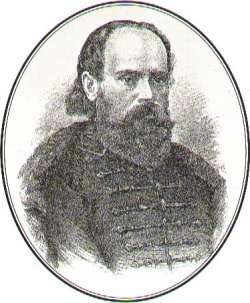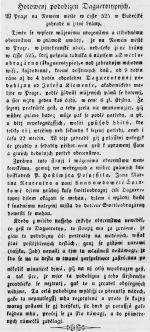Jozef Božetech Klemens
 | |
| Born |
March 8, 1817 Liptovský Mikuláš, Kingdom of Hungary, Austrian Empire |
|---|---|
| Died |
January 17, 1883 (aged 65) Vienna, Austria-Hungary |
Jozef Božetech Klemens was a 19th-century painter, sculptor, technician-inventor, chemist, geologist, botanist, archeologist, photographer and teacher.[1] He was a member of Matice česká (since 1837 or 1838) and founding member of Matica slovenská (1863).[2] He was also a member of the Imperial Geological Institute in Vienna (from 1858), honorary member of the Hungarian Scientific Society in Pest (from 1862), and member of the department of life sciences and geology of Matica slovenská (from 1869).[3]
Contents
Early life
Born in Liptovský Mikuláš, Kingdom of Hungary (today Slovakia), into a family saddler, originally from Kłodzko (today Kladsko) in Czech-Polish borderland. His mother was born Čerepovská.[4]
Prague and photography practice (1837-43)

In 1837, he was visited by Karel Slavoj Amerling and priest Václav Svatopluk Štulc in his home town after suggestion of Gašpar Fejérpataky-Belopotocký whom Klemens occasionally helped with book printing. He was admitted for a trial period at the Academy of Fine Arts in Prague the same year. In 1838-1843 he studied there as a regular student, also attending lectures on science and technics. In 1839, Amerling accepted him as a teacher at his newly founded girls school in Budeč, where they both experimented with the pedagogical principles Comenius laid down in his Orbis Pictus.[6]
He became interested in daguerreotype and shortly after its introduction, in April 1842 he opened a photo studio called Světloobrazárna in the garden of Budeč school.[7][1] It was the second photographic studio in Prague (Wilhelm Horn opened one in October 1841 [2]). Portraits were relatively expensive (6 Gulden) and due to financial difficulties it closed down the following year.
In Prague he met a number of Czech cultural personalities, including Rieger, Hanka, Čelakovský, Purkyně, and Palacký, and for next two decades he was inclined more to Kollárian concept of czecho-slovak language unity rather than Štúrian language and national sovereignty.[8] Along with Peter Michal Bohúň he was a central figure in artistic life of high phase of the Slovak national revival, he initiated specific Slovak artistic line. His artistic expression combined classicism with romantic elements. His artistic importance is primarily in portraiture, however later he was influenced by nazarenism. He painted religious compositions, repeated them without an inventive approach.
Slovakia (1843-47)
In 1843 he returned to Slovakia (then Kingdom of Hungary). He conducted geological research in the regions of Orava and Šariš. He worked in Tatrín society for which he painted portraits of several Slovak revivalists. He was involved in paint color production, and became known as scientific and industrial specialist and builder. In 1846 the city council of Banská Bystrica invited him to develop the project of industrial school (probably upon his own initiative).[9]
Prague, Liptovský Mikuláš (1847-55)
In 1847 he moved back to Prague to attend lectures on medicine and chemistry at Prague University and the Polytechnic Institute of Chemistry (he was particularly interested in sugar production and metallurgy), and completed his studies in August 1849. During his studies, in 1848 he married his former student from Budeč, Adéla Kuglerová. Amerling's Budeč school closed down in 1848 because of its Slavophil orientation, and Klemens made living only from making portraits. 1848 revolts also "distracted" him and in late 1849 he moved together with his wife to more downbeat Liptovský Mikuláš where he used her dowry to build a workshop for the production of zinc oxide. He also designed and constructed equipment of the workshop. The company soon bankcrupted though. He was living off mainly church paintings (in Veľký Bobrovec, Nemecká Ľupča, or Palúdzka near Mikuláš), thinking about emigrating to Russia.[10]
Geological research
In 1854 together with P. Árvajs he discovered stone coal and color marble sites. Juraj Chovan considers Klemens to be an author of fake runic texts found in the Kremnické mountains because of his erudition in history, fine arts, and geology.[11] He owned one of the largest collections of minerals in Slovakia.
Belgrade, Prague, Žilina (1855-63)
Finally, he accepted an offer from Ján Šafárik, nephew of Pavol Jozef Šafárik, for a teaching position at the Lyceum in Belgrade. He traveled there in Spring 1855 on a self-made raft. With his wife, two kids and property he sailed to Pest where he sold a raft and continued to Belgrade by ship. Here he made a sculpture of Serbian patriot Karađorđe, and geological map of Montenegro. However, he stayed in Belgrade only for five months because health of his family suffered from local climate. The same year he traveled to Prague. Here in 1855-1856 he began his studies at the higher secondary school to get qualification to teach in secondary schools. He passed the teacher exams in chemistry, physics, life sciences, Czech and German. In 1856 he won a position of drawing teacher at the secondary school in Žilina where he worked until it closed down in 1863. He also conducted geological research during his tenure in Žilina.[12]
Family
Klemens had five children with his first wife Adéla: Bohdana, Ľudmila, Vladimír, Bohuslav-Peter (pharmacist in Prague), and Cyril-Karol (pharmacist in Vienna). She died in 1867. He married again in 1869 with Antónia Riznerová from Kláštor pod Znievom. From this second marriage the son Jozef was born.[13]
Later years in Banská Bystrica (1860s-83)
Afterwards he served as a visiting and since 1873 as a permanent professor of life sciences and art at the Catholic high school in Banská Bystrica. At that time he turned back to portraiture, depicting many personalities of cultural and literary life in Slovakia. In 1878 he was pensioned off (800 Gulden) partially because of his patriotic views. He spent his last five years teaching at Catholic elemenary school and Protestant secondary school in Banská Bystrica.[14] In 1876-80 his studio was regularly visited by young Jozef Murgaš, to-be priest, painter and inventor.
Inventions
Interest in technical sciences led him in 1862 to draft the printing machine named Samotlač whose drawings he sent to an exhibition in London. From the mid-1870s he had attempted to construct a steam engine Žiaroruch based on the principle of dry ice propulsion. The machine was meant to serve as today's excavator, crane, and bulldozer. He didn't manage to build it and neither was granted patent. An interesting moment in this invention was also the possibility to use hot air to fill up the balloon, lift the machine and transport it easily.[15]
Death
He suffered from kidney stones and in January 1883 he went to Vienna to undergo surgery. The operation failed, however, and its consequences led to his death. He was buried at Vienna's Central Cemetery. 39 years later, his son Cyril-Karol was buried there too. The gravesite's lease however expired in 1948 and gravestone was removed in 1960.[16]
Works
- Portraits
- centurion Burian (pencil, 1838)
- J. K. Tyl (pencil, 1841)
- soldier Ladislav Gábriš-Škultéty (1857), the world's oldest soldier [3]
- Štefan Moyzes (1871) [4]
- Andrej Sládkovič (oil, 1872) [5]
- Ľudovít Štúr (oil, 1873) [6]
- Michal Hodža
- Božena Němcová
- director of girl school in Banská Bystrica and scientist Andrej Zipser (oil, 1876)
- Ludvík Turzo-Nosický of Banská Bystrica (oil, 1876)
More than 100 of his paintings is preserved, in the collections of the Slovak National Gallery in Bratislava, in the National Gallery in Prague and Prague City Museum.
- Sculptures
- Ján Žižka (lead)
- Karađorđe (gypsum)
- Church paintings
- painting of St. Jan Nepomucký in St John Church, Bobrovec
- Horná Lehota (Dolný Kubín county)
- St. Cyril and Method Church, Mojtín
- Nemecká Ľupča
- Pružina
- Turzovka
- Žilina [7]
- Other works
- brewery project in Žilina
- geological map of Liptov county
- geological map of Trenčín county
- geological map of Montenegro
Notes
- ↑ Chovan 1985, p. 68, in a letter to his friend Amerling he said the only discipline he did not get involved with was music.
- ↑ Chovan 1985, p. 69
- ↑ Chovan 1985, p. 68
- ↑ Chovan 1985, p. 64
- ↑ Klemens 1842
- ↑ Chovan 1985, pp. 64-65
- ↑ Klemens 1842
- ↑ Chovan 1985, p. 65
- ↑ Chovan 1985, p. 65
- ↑ Chovan 1985, pp. 65-67
- ↑ Chovan 1985, pp. 71-73
- ↑ Chovan 1985, pp. 67-68
- ↑ Chovan 1985, p. 66
- ↑ Chovan 1985, pp. 69-70
- ↑ Chovan 1985, pp. 70-71
- ↑ Chovan 1985, p. 64
Literature
- Chovan, Juraj (1985). "Jozef Božetech Klemens - známy i neznámy". Biografické štúdie (Martin: Matica slovenská) (12): 64-73. ISSN 1338-0354 (Slovak).
- Kálmán, Július (1978). Jozef Božetech Klemens. Bratislava: Pallas (Slovak).
- Klemens, Jozef (5 1842). "Hotovwenj podobizen Daguerotypnjch". Česká wčela 9 (35): 139-140. ISSN 1338-0354 (Old Czech).
- Pöss, Ondrej; Ladislav, Švihran (2002). Majstri ducha (in Slovak). Bratislava: Perfekt. 81 pp.
- Toman, Prokop (1947). "Klemens, Jozef Božetech". Nový slovník československých výtvarných umělců. 1 (3 ed.). Prague: Rudolf Ryšavý. pp. 488-489 (Czech).
External links
- Works by Klemens at WebUmenia.sk
- Klemens at Osobnosti.sk (Slovak)
- Klemens at Slovak Wikipedia
- Klemens at Czech Wikipedia